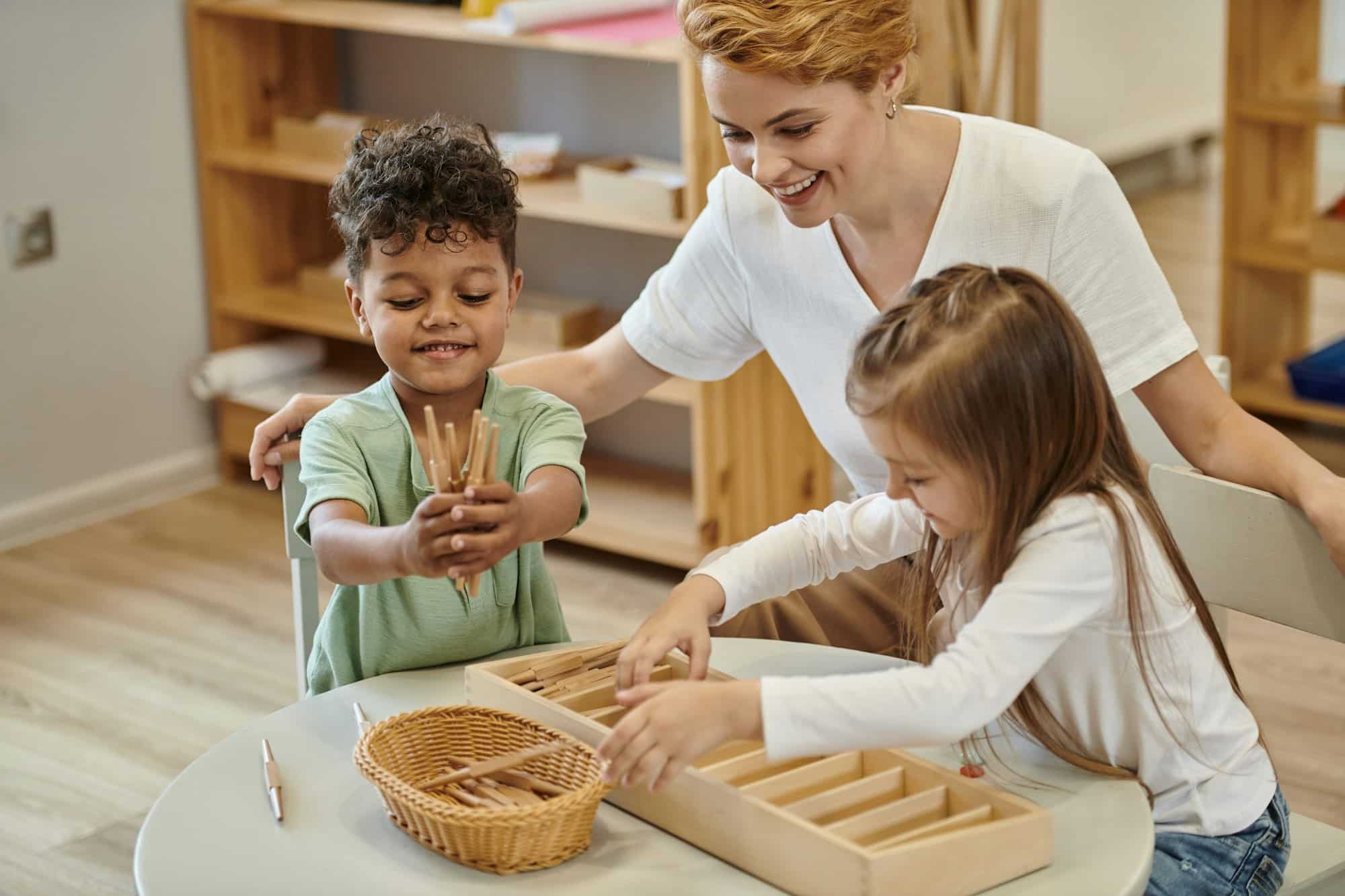What’s the Best Way to Create a Safe, Stimulating Montessori Playroom for Toddlers?

When it comes to the development of your child, the environment in which they play and learn is of paramount importance. As parents, you strive to provide the most supportive and engaging space for your children. One way to foster this nurturing environment is by creating a Montessori-style playroom. This approach emphasizes natural materials, hands-on activities, and self-directed learning. It’s a proven method that enhances a toddler’s skills and development.
Understanding the Montessori Method
The Montessori method is a child-centered educational approach developed by Dr. Maria Montessori. It emphasizes independence, freedom within limits, and respect for a child’s natural psychological, physical, and social development.
A lire en complément : How to Select the Right Insulation for a Warm and Quiet Home Theatre?
In a Montessori playroom, the focus is on providing toys and materials that promote active, experiential learning. Rather than merely entertaining your child, these items serve as learning tools that engage their senses, stimulate their minds, and foster their natural curiosity.
Creating a Montessori playroom for your toddler is not about buying the most expensive materials or filling the room with countless toys. Instead, it’s about carefully selecting items that serve a purpose, and arranging them in a way that invites exploration and independent play.
Sujet a lire : How Can You Design a Multi-Purpose Guest Room with a Fold-Down Murphy Bed?
Selecting the Right Toys and Materials
When it comes to selecting toys for a Montessori playroom, consider quality over quantity. Montessori materials are designed to promote active learning and develop specific skills. They are typically made from natural materials like wood, metal, or glass, which provide a range of textures for your toddler to explore.
Avoid toys with too many bells and whistles. Overstimulating toys can distract your child from the learning process. Instead, opt for simple, well-crafted items that your child can explore in a multitude of ways, such as blocks, puzzles, and art supplies.
Also, remember to rotate toys regularly. This will keep the playroom fresh, exciting, and stimulating for your toddler.
Creating the Ideal Montessori Play Space
A Montessori playroom should be a thoughtfully designed, inviting space that encourages your child to explore, learn, and grow independently. It’s crucial to arrange the room in a way that makes sense to your child.
Design the playroom so that everything is within your child’s reach. This promotes independence and allows your kid to choose what they want to play with.
Create different areas for various activities. For example, a reading nook with a comfortable chair and a bookshelf at your child’s height encourages an interest in reading. An open area with soft mats invites physical play and movement.
Ensure your playroom is safe. Use child-friendly furniture with rounded edges, secure large items to the wall to prevent tipping, and keep small objects out of reach to avoid choking hazards.
Incorporating Natural Elements
Including natural elements in your Montessori playroom can foster an appreciation and understanding of the natural world. Consider incorporating plants, natural light, and items made from natural materials.
Plants can improve air quality and add a calming element to the room. They also provide an opportunity for your child to learn about caring for other living things.
Natural light is also important for a child’s development. It aids with the body’s natural circadian rhythms and encourages healthy sleep patterns.
Items made from natural materials such as wood, wicker, and cotton provide a variety of textures for your child to explore. They also tend to be more durable and safer than plastic toys.
Encouraging Independent Play and Learning
The ultimate goal of a Montessori playroom is to foster self-directed learning. Encourage your child to choose their activities and let them play independently. This doesn’t mean leaving them alone completely, but allowing them to lead their play.
Create an environment that supports this by offering a range of age-appropriate toys and activities. Also, ensure the room is safe so you can feel comfortable allowing your child to explore on their own.
Remember, the objective is not to keep your child busy, but to create a stimulating environment that invites them to engage, explore, and learn.
As you venture into creating your Montessori playroom, remember it doesn’t have to be perfect. It’s about creating a space where your child feels safe, stimulated, and free to explore. It’s about providing an environment that supports their growth and development at their own pace. This approach can provide a strong foundation for your child’s life-long learning journey.
Enhancing Motor Skills and Problem Solving Abilities
One of the significant benefits of a Montessori playroom is the enhancement of motor skills and problem-solving abilities in toddlers. By integrating Montessori toys and activities tailored towards this, you can help your child develop these skills in a fun and engaging manner.
For instance, stacking blocks, threading beads, and using shape sorters are excellent ways to enhance fine motor skills and hand-eye coordination. Encourage your child to learn at their own pace. These activities challenge your toddler to manipulate objects with their hands, which is essential for mastering other skills such as writing and dressing.
To help your toddler develop gross motor skills, include activities that promote movement such as a small climbing wall, balance beam, or just a simple open area to crawl and toddle around. Encourage your child to be active, which will contribute to their physical health and development.
To boost problem-solving skills, consider toys and materials that challenge your toddler to think critically. Simple puzzles, pattern blocks, and open-ended building sets can foster cognitive development and problem-solving abilities.
Remember that age appropriate toys are key in a Montessori play area. Your child should be challenged, but not frustrated by tasks that are beyond their developmental stage.
Building a Reading Corner
A reading corner is a vital part of a Montessori playroom. Not only does it encourage a love for reading from a young age, but it also acts as a calm and quiet space for your child to unwind.
When setting up a reading nook, consider including a comfortable child-sized chair or cushions for your toddler to sit on. Place a small bookshelf at your child’s level, filled with a variety of age-appropriate books.
It’s essential to incorporate a mix of picture books, storybooks and interactive books with flaps or textures. This variety will cater to your toddler’s growing interests and stimulate their imagination.
Remember to rotate the books regularly to keep your child engaged and excited about reading. This also exposes them to a variety of topics and ideas, expanding their knowledge and curiosity.
Conclusion: Create a Montessori Inspired Play Space
Creating a Montessori playroom is a valuable investment in your child’s early development. By providing a carefully considered play space, you’re encouraging your toddler to explore, learn, and grow independently.
Remember, the playroom doesn’t need to be filled to the brim with toys and materials. A few well-chosen, age-appropriate Montessori toys, a variety of activities to enhance motor skills, and a cozy reading nook can create a stimulating environment.
While setting up, safety should be your utmost priority. All items should be child-friendly, and potential hazards should be eliminated.
Embrace the Montessori method’s principles in your playroom to foster a love for learning in your toddler. This will not only support their current development but also lay a strong foundation for their future learning journey.
So, go ahead, add that wooden puzzle to your cart, arrange those child-sized chairs, and create an inviting, innovative Montessori inspired playroom for your little one. It’s not about perfection, but about creating a space where your child feels inspired to explore and learn at their own pace.
